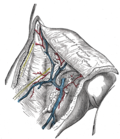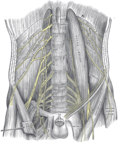| Lateral cutaneous nerve of thigh | |
|---|---|
 Plan of lumbar plexus. (Lateral femoral cutaneous visible at left.) | |
 Cutaneous nerves of the right lower extremity. Front and posterior views. | |
| Details | |
| From | Lumbar plexus (L2–L3) |
| Innervates | Skin on the lateral part of the thigh |
| Identifiers | |
| Latin | nervus cutaneus femoris lateralis |
| TA98 | A14.2.07.011 |
| TA2 | 6521 |
| FMA | 16485 |
| Anatomical terms of neuroanatomy | |
The lateral cutaneous nerve of the thigh (also called the lateral femoral cutaneous nerve) is a cutaneous nerve of the thigh. It originates from the dorsal divisions of the second and third lumbar nerves from the lumbar plexus. It passes under the inguinal ligament to reach the thigh. It supplies sensation to the skin on the lateral part of the thigh by an anterior branch and a posterior branch.
Contents
- Structure
- Origin
- Course and relations
- Branches
- Distribution
- Variation
- Function
- Clinical significance
- Ultrasound
- Nerve block
- Meralgia paraesthetica
- History
- Additional images
- See also
- References
- External links
The lateral cutaneous nerve of the thigh can be investigated using ultrasound. Local anaesthetic can be injected around the nerve for skin grafts and surgery around the outer thigh. Nerve compression (usually around the inguinal ligament) can cause meralgia paraesthetica.




